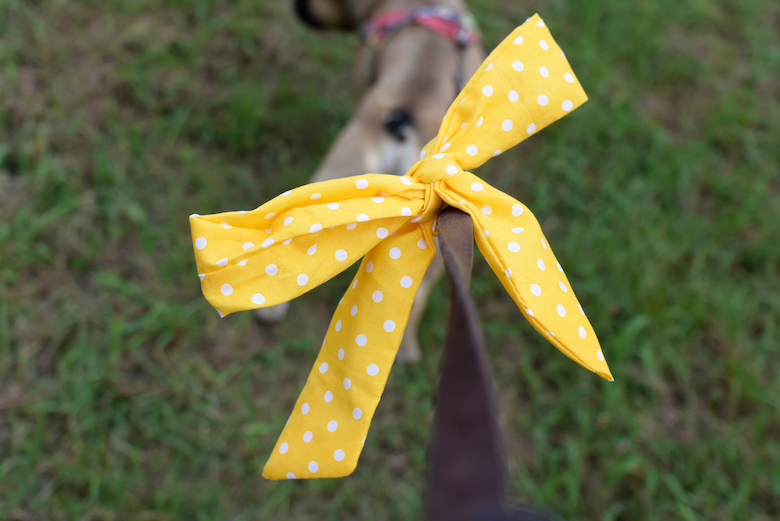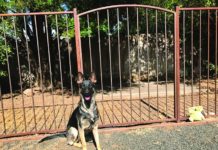I grew up around horses. In the horse world, if you tie a red ribbon in your horse’s tail, everyone knows that means your horse kicks – so you don’t walk behind that horse, or ride your own horse too close to that horse’s back end. If you do, and you get kicked, it’s your own fault. So, everyone stays away from the rear end of a horse with a red ribbon in her tail. There is an active effort in the dog world to do something similar with the color yellow to protect dogs who need others to respect a space bubble around them as well as educate people about appropriate interactions with dogs in public in general (DINOS – Dog In Need Of Space).
A Yellow Dog or DINOS may be aggressive, but is not necessarily so. He may be fearful and/or reactive, and needs people or other dogs not to get too close. He may be in pain – recovering from recent surgery, or arthritic, and again, needs dogs and humans not to pester him. He may just be too friendly and his human doesn’t want to constantly have to deal with him jumping up on people. He may be in training, and needs to focus on his tasks-at-hand rather than being intruded upon; a service dog, perhaps, or a dog just in the early stages of his good manners training. Perhaps he’s simply the canine companion of a human who wants to keep distance between herself and her dog, and others.
The Yellow Dog Project is a not-for-profit organization promoting the concept of “yellow means caution” for dogs, and they have representatives around the world, in North and South America, parts of Africa, Asia, Russia, Australia, and numerous European countries. They utilize volunteers globally to help educate dog owners and others, and offer Yellow Dog volunteer opportunities, resources and products on their website and Facebook page.
DINOS was launched in 2012 by founder, professional dog walker and Certified Compassion Fatigue Educator, Jessica Dolce. As a dog walker, she faced regular encounters with humans who allowed their dogs to inappropriately approach the dogs she was professionally responsible for, many of whom didn’t appreciate other dogs in their faces. She calls these people MDIFs, because they often approach with a big smile on their faces while proclaiming enthusiastically, “It’s okay, My Dog Is Friendly.” Fed up with these encounters, she started a project to educate both dog owners and non-dog owners about better ways to interact with dogs in the real world. Her website offers a wide variety of resources both for those who have DINOS as well as those who want to help educate the rest of the world about how to interact appropriately with dogs in public. You can find DINOS information and resources on their website and Facebook page.
It is certainly no fun for a dog owner (or dog walker, or dog trainer) to constantly have to ward off unsolicited approaches, and it’s even worse when your dog does have reactive or aggressive behaviors. I would love to see yellow vests, scarves and ribbons become as well-known a “stay away” signal in the dog world as a red ribbon in a horse’s tail is in the horse world. Whether you purchase and utilize dog-space education products for your own Yellow Dog/DINOS, sign up to volunteer for the Yellow Dog Project, or share educational products in your community, (you can find the Yellow Dog poster online, free download, print, make copies and post them around your neighborhood), you can help these groups help make the world a safer and happier place for dogs and the people who love them.
Read Next: Aggression Unpacked, May 2019







My usual comment when someone says “Oh my dog is friendly” is to respond, “so is mine…BUT I AM NOT!”. Usually makes them pause.
Worse for me (with a 60 lb. Am Staff, who is WAY too friendly) are the people who say “Oh I don’t mind if he jumps” (as they are reinforcing him for jumping by petting him), and he is dragging me over to them. I’ve considered a paint ball gun (for the people, NOT for my dog) but suspect I’d get in to a lot of trouble .
Stay safe.
Kitti
So funny 🙂
Hi, Pat.
I have heard from some professional trainer groups that there may be some liability if you use yellow to ID your dog as nervous/reactive/ aggressive/etc. Their reasoning is that you are admitting knowledge to your dog being aggressive. I had always thought it a nice idea, as your article states, but now am wondering if they have a point. Thoughts?
There is some merit to that reasoning. You are advertising that your dog may be aggressive and cause harm, and if someone is injured it could easily be used as evidence of prior knowledge.
What a great idea! My last two rescues have been fear-reactive, and many positive behavior training classes helped them both, plus teaching class members to respect the doggos who need space. However, the real world is a different place, so rather than putting my current girlie into unsafe situations, we play in our own yards and take car rides, but only get out at the vet. Such a contrast to my other dog, a purebred, who participated in many conformation shows to her championship, and where these large events are safe, people are respectful of others’ dogs and space, and dogs are well-socialized. I’m just not willing to risk the rescue girl, who is making slow but continual progress, to be a victim of dogs with untrained owners.
You’re lucky to have that option of a yard. I have to walk my new adopted rescue dog in a city environment in parks that are not big and he is not capable of passing other dogs on the sidewalk without a meltdown so I have to do a lot of U-turns and backtracks. Sometimes, backtracking, I suddenly run into another dog and find myself boxed in. My dog will be lunging like crazy and people don’t veer their dogs away because they don’t know not to, but keep on coming in a straight line. His red line threshold is about 30 m. Educating the wider dog community is a good idea but really difficult to achieve. Posters in veterinary waiting rooms might help.
I love this idea in theory, as I have a fear-reactive dog who needs lots of space, and have had to ask and sometimes strongly INSIST that others to please back away. But sadly, I don’t have a lot of hope of this catching on in our country at a time when some people are threatening each other with VIOLENCE for simply wearing a mask.. This excellent educational opportunity (for people to learn more about dogs needing space) requires that people are open to being educated, and I fear this is starting to be in short supply…
I have seen this idea floating around for about 20 years, but it unfortunately never seems to take hold (I’ve seen orange, red and yellow recommended). I think one difference is that people in horses are a more select group (approximately 1.7% of US population); whereas over 60% of the US population has dogs. The dog-owning population is clearly not as savvy, and gets most of their “knowledge” from TV. Also, unfortunately, common sense of “everyone knows” does not reliably exist in the dog-owning population.
Back when I was competing in nosework, reactive dogs were allowed, as long as they wore a red bandanna and kept away from other dogs. I didn’t agree with the idea because I don’t think it’s fair to the other dogs. A dog that can’t behave around other dogs shouldn’t be allowed to compete. Particularly since we were expected to make way for these dogs, rather than the other way around.
Having said that, the yellow ribbon idea might be good for “real life,” but it would have to be common knowledge for it to work. I had never heard of it, but I’m happy to spread the word and if we all do that, it might eventually become the norm. Keeping in mind that most dog owners are clueless…:-)
At one point your say they reactive dog owners had to keep away from other dogs, as a a condition to keep. The n you say “we were expected to make way for these dogs rather than the other way around.” It seems to be a contradiction.
One of my MAJOR pet peeves is people who say, my dog is friendly. YOUR dog might be friendly, but my little Yorkie was attacked twice, once by a huskie and then by a pit bull who burst out of the house to get at my friend and I and our dogs. Not to mention all the times, idiot owners let their dogs off leash anywhere and everywhere which gives them carte blanche to run at MY dog who is terrified. She is tiny, yet mighty and thinks this means she has to protect herself and ME. Every time something like this happens, it makes her worse. She has no idea that all dogs will not hurt us.
I would love to see something like yellow dogs be common place!!
Actually, it is a red ribbon you braid into your horse’s tail in the US. I recently came in possession of a 15mo German Shepherd due to the unexpected death of her Mom and my best friend. I have had and fostered German Shorthair Pointers for 50 yrs, so a GSD is a totally new breed to learn. She was never socialized, so the typical wariness etc. is my new challenge. She is now living and enjoying 7 acres with my 3 GSPs and getting socialized , learning to run, play and be a good citizen. I am working with the trainers of a local facility for the socialization, impulse control and confidence building.
I don’t believe that the Yellow Dog Project has been active for a few years. We have utilized their concept, posters, and provided yellow ribbons for our Club dogs and public class dogs. Two of our Club (I was one) members applied to be representatives, but no Welcome packages ever arrived, and no responses to emails (sent in 2015 and 2016) asking for updates…. We support the concept, and have continued to hope that someone would take on the terrific idea and help us keep it active and recognized.
This is something that has been around in the dog community where I live for several years. While it doesn’t seem to have caught on in the broader community yet, it has sure been helpful to give a visual reminder to vets /professionals at an entry that my nervous, neurologically different dog needs a slow approach. My vet’s office keeps a bowl of yellow ties at the desk for free with information about what they mean. I’d LOVE to see it come into broader use as an educational tool.
This is such a good idea. We got our Mini Schnauzer last December. We stretched her vaccines over several weeks as a precaution. She got her last round mid Feb. Two weeks later she was able to be around other dogs and two weeks after that we were in quarantine and she hasn’t seen another person or animal since. She will definitely end up being a DINOS. And we all may need therapy.
Here in Scotland we have Red for Caution, Orange No Dogs, Green Friendly, Yellow Nervous and Blue for Training
Hi most of the dogs need a big space just to be free sometimes when you have a dog and you space is to little you dog get bored all the time.
This organization has not been operating for YEARS! I was one of the 2 North Alabama representatives. We promoted this (and continue to this day) in our classes at HOTC. Sadly, you need to know that there is no longer “The Yellow Dog Project” group. Please check yourself. The last post on their FB page was 4 years ago. It was a volunteer organization which faded away…..
I am sure people who are aware of reactive dogs would totally understand the warning. The problem that I see is the people who are not aware, a lot of people have just never experienced or learned that some dogs aren’t open and friendly. what works best for me is just to bluntly yell at a safe distance” hey, stay away my black dog isn’t friendly!”